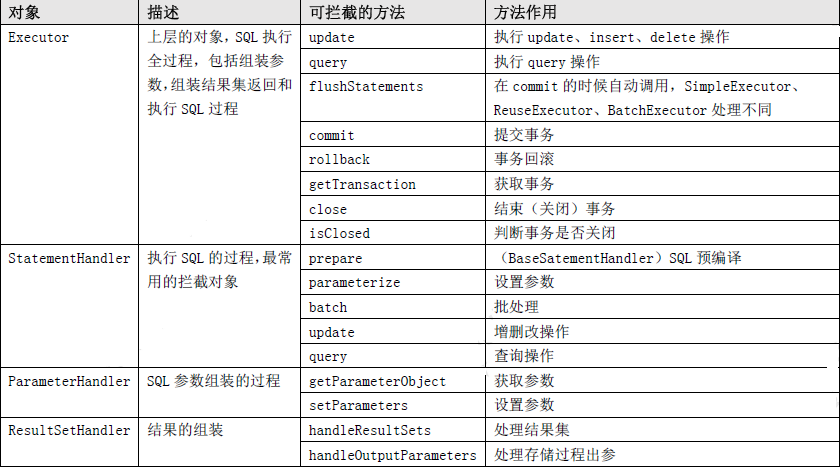官方文档:https://mybatis.org/mybatis-3/zh/configuration.html#plugins
MyBatis 允许你在已映射语句执行过程中的某一点进行拦截调用。默认情况下,MyBatis 允许使用插件来拦截的方法调用包括:
- Executor (update, query, flushStatements, commit, rollback, getTransaction, close, isClosed)
- ParameterHandler (getParameterObject, setParameters)
- ResultSetHandler (handleResultSets, handleOutputParameters)
- StatementHandler (prepare, parameterize, batch, update, query)
这些类中方法的细节可以通过查看每个方法的签名来发现,或者直接查看 MyBatis 发行包中的源代码。 如果你想做的不仅仅是监控方法的调用,那么你最好相当了解要重写的方法的行为。 因为如果在试图修改或重写已有方法的行为的时候,你很可能在破坏 MyBatis 的核心模块。 这些都是更低层的类和方法,所以使用插件的时候要特别当心。

例子:
@Intercepts({@Signature(type = Executor.class, method = "query", args = {MappedStatement.class, Object.class, RowBounds.class, ResultHandler.class})})
public class ExamplePlugin implements Interceptor {
@Override
public Object intercept(Invocation invocation) throws Throwable {
//执行前处理
Object returnObject = invocation.proceed();
//执行后处理
return returnObject;
}
@Override
public Object plugin(Object target) {
//生成代理对象,如果不是处理的接口,就返回原对象
return Plugin.wrap(target, this);
}
@Override
public void setProperties(Properties properties) {
}
}
在mybatis-config.xml中配置
<plugins> <plugin interceptor="org.xuan.springmvc.comp.ExamplePlugin" /> </plugins>
分析:
在处理mybatis-config.xml配置文件的时候读取到plugins节点时,会把插件加入到Configuration#interceptorChain里面
1.使用XMLConfigBuilder#parse解析配置文件
public Configuration parse() { if (parsed) { throw new BuilderException("Each XMLConfigBuilder can only be used once."); } parsed = true; parseConfiguration(parser.evalNode("/configuration")); return configuration; }
在parseConfiguration中处理各种配置
private void parseConfiguration(XNode root) { try { //issue #117 read properties first propertiesElement(root.evalNode("properties")); Properties settings = settingsAsProperties(root.evalNode("settings")); loadCustomVfs(settings); typeAliasesElement(root.evalNode("typeAliases")); //处理插件 pluginElement(root.evalNode("plugins")); objectFactoryElement(root.evalNode("objectFactory")); objectWrapperFactoryElement(root.evalNode("objectWrapperFactory")); reflectorFactoryElement(root.evalNode("reflectorFactory")); settingsElement(settings); // read it after objectFactory and objectWrapperFactory issue #631 environmentsElement(root.evalNode("environments")); databaseIdProviderElement(root.evalNode("databaseIdProvider")); typeHandlerElement(root.evalNode("typeHandlers")); mapperElement(root.evalNode("mappers")); } catch (Exception e) { throw new BuilderException("Error parsing SQL Mapper Configuration. Cause: " + e, e); } }
然后解析plugins
private void pluginElement(XNode parent) throws Exception { if (parent != null) { for (XNode child : parent.getChildren()) { String interceptor = child.getStringAttribute("interceptor"); Properties properties = child.getChildrenAsProperties(); Interceptor interceptorInstance = (Interceptor) resolveClass(interceptor).newInstance(); interceptorInstance.setProperties(properties); //添加到配置类中 configuration.addInterceptor(interceptorInstance); } } }
在执行mybatis期间,使用Configuration创建提供处理的4种对象的时候会去判断是否和插件处理的接口是否一致
public ParameterHandler newParameterHandler(MappedStatement mappedStatement, Object parameterObject, BoundSql boundSql) { ParameterHandler parameterHandler = mappedStatement.getLang().createParameterHandler(mappedStatement, parameterObject, boundSql); parameterHandler = (ParameterHandler) interceptorChain.pluginAll(parameterHandler); return parameterHandler; } public ResultSetHandler newResultSetHandler(Executor executor, MappedStatement mappedStatement, RowBounds rowBounds, ParameterHandler parameterHandler, ResultHandler resultHandler, BoundSql boundSql) { ResultSetHandler resultSetHandler = new DefaultResultSetHandler(executor, mappedStatement, parameterHandler, resultHandler, boundSql, rowBounds); resultSetHandler = (ResultSetHandler) interceptorChain.pluginAll(resultSetHandler); return resultSetHandler; } public StatementHandler newStatementHandler(Executor executor, MappedStatement mappedStatement, Object parameterObject, RowBounds rowBounds, ResultHandler resultHandler, BoundSql boundSql) { StatementHandler statementHandler = new RoutingStatementHandler(executor, mappedStatement, parameterObject, rowBounds, resultHandler, boundSql); statementHandler = (StatementHandler) interceptorChain.pluginAll(statementHandler); return statementHandler; } public Executor newExecutor(Transaction transaction) { return newExecutor(transaction, defaultExecutorType); } public Executor newExecutor(Transaction transaction, ExecutorType executorType) { executorType = executorType == null ? defaultExecutorType : executorType; executorType = executorType == null ? ExecutorType.SIMPLE : executorType; Executor executor; if (ExecutorType.BATCH == executorType) { executor = new BatchExecutor(this, transaction); } else if (ExecutorType.REUSE == executorType) { executor = new ReuseExecutor(this, transaction); } else { executor = new SimpleExecutor(this, transaction); } if (cacheEnabled) { executor = new CachingExecutor(executor); } executor = (Executor) interceptorChain.pluginAll(executor); return executor; }
因为插件实现了
@Override public Object plugin(Object target) { return Plugin.wrap(target, this); }
如果是插件配置的处理接口的时候会返回一个代理对象
public static Object wrap(Object target, Interceptor interceptor) { Map<Class<?>, Set<Method>> signatureMap = getSignatureMap(interceptor); Class<?> type = target.getClass(); Class<?>[] interfaces = getAllInterfaces(type, signatureMap); if (interfaces.length > 0) { return Proxy.newProxyInstance( type.getClassLoader(), interfaces, new Plugin(target, interceptor, signatureMap)); } return target; }